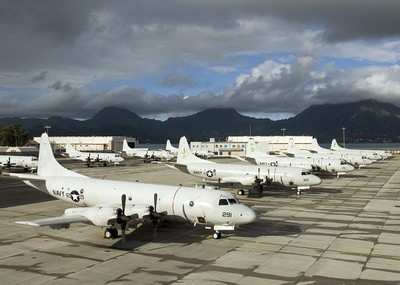Newly Installed Computer Hardware, Software Will Save Money,
Improve Capabilities
NAVAIR (Naval Air Systems Command) recently delivered ten newly
configured Orions to the Fleet, outfitted with an upgraded acoustic
system called the Acoustic Receiver Technology Refresh (ARTR).
Acoustic systems with ARTR are a vital component of the P-3C
mission systems, enhancing the ability to receive and analyze
sonobuoy data; a primary function of the P-3C mission. ARTR
improved performance over the existing P-3C acoustic system was
demonstrated during several recent exercises with a tenfold
increase in system operating reliability. This latest upgrade
continues the process of bridging the gap in technology between the
Orion and the P-8A Poseidon and becomes the catalyst for
commonalities among Fleet aircraft.

A significant benefit of the new system includes having one
person lead the acoustic system program for the P-3C and the P-8A.
This change means acoustic testing on the P-3C helps mitigate risk
for the P-8A. Other benefits include common signal processing code,
common hardware, and the opportunity to develop the system once for
both aircraft. By combining resources and providing an upgrade to
the P-3C which will be used in the P-8A, the Fleet could see long
term efficiencies in training and greater financial benefits
overall.
"As we look ahead to the future, our goal is to be smart about
how we approach growth of the MPRA Fleet. If we enhance the P-3C
now with a similar system used in the P-8A, it's a win-win for the
Fleet," said CAPT Mike Moran, Program Manager for PMA 290.
"Ultimately, we want a program that is more efficient and more cost
effective than ever before and that's what we strive for
everyday."
ARTR is the first of two steps that will help bring mission
systems on the Orion up to par with the new Poseidon. NAVAIR plans
to deliver 74 mission-ready Orions installed with ARTR by 2012.
During the next two years, P-3 acoustic system upgrades will be
aimed at improving system maintainability and digital sonobuoy
monitoring capability, increasing system architecture openness, and
growth of multi-static sensor processing capability. After the
initial upgrades to the Orion, both the P-3C and the P-8A will
undergo the second phase of system upgrades called the Acoustic
Processor Technology Refresh (APTR). APTR will enable both maritime
patrol and reconnaissance aircraft to operate using a similar set
of acoustic software by 2014.

The acoustic program provides and improves anti-submarine
warfare (ASW) capability required to neutralize enemy submarine
threats. It establishes a common, but not identical, configuration
of processors, recorders and receivers.
Additional technology currently being installed in the Orions,
and keeping them relevant for years to come, includes C4 for ASW
(Command, Control, Communications and Computers for anti-submarine
warfare). The Navy is currently installing the first P-3C with C4
for ASW, a computer system allowing for broader network
capabilities to support the ASW mission. Specifically, the system
includes LINK-16, which provides enhanced situational awareness and
interoperability with U.S. Navy surface fleet, other military
services, and NATO forces; and an international maritime satellite
(INMARSAT), that provides encrypted broadband services for the
Fleet. These critical components will provide enhanced
communications, resulting in stronger mission capabilities for
current P-3C operators, and more seamless transitioning to the
P-8A.
 Classic Aero-TV: In Praise of Alabamas Patriot Aircraft USA
Classic Aero-TV: In Praise of Alabamas Patriot Aircraft USA NTSB Final Report: Cirrus Design Corp SR22
NTSB Final Report: Cirrus Design Corp SR22 ANN's Daily Aero-Term (12.21.25): Dead Reckoning
ANN's Daily Aero-Term (12.21.25): Dead Reckoning ANN's Daily Aero-Linx (12.21.25)
ANN's Daily Aero-Linx (12.21.25) Aero-News: Quote of the Day (12.21.25)
Aero-News: Quote of the Day (12.21.25)




